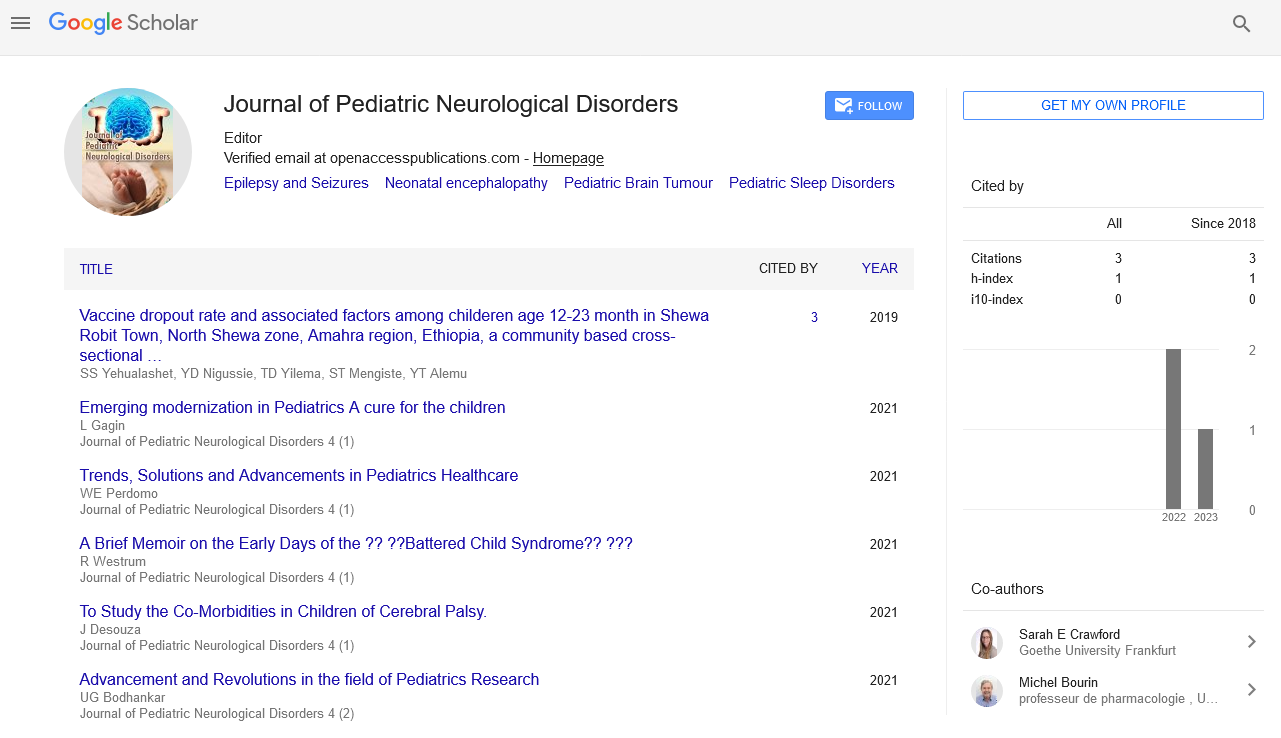Commentary - Journal of Pediatric Neurological Disorders (2022) Volume 5, Issue 3
A Short Note on Evaluation of Biochemical Changes in Chronic Arsenic Poisoning among Bangladeshi Patients
Aisha Sehari*
Tripoli University, Faculty of Medicine, Tripoli, Libya
Received: 02-Jun-2022, Manuscript No. pnn-22-421010; Editor assigned: 06-Jun-2022, PreQC No. pnn-22- 421010(PQ); Reviewed: 20-Jun-2022, QC No. pnn-22-421010; Revised: 23-Jun-2022, Manuscript No. pnn-22- 421010(R); Published: 30-Jun-2022, DOI: 10.37532/pnn.2022.5(3).50-51
Abstract
An estimated 40 million people in Bangladesh have been suffering from arsenic toxicityrelated diseases because of drinking water contamination with high levels of naturally occurring arsenic. Drinking water, urine and peripheral blood samples were collected from all participants and analyzed. The average levels of arsenic in the drinking water and spot urine samples of the arsenicosis patients were 218.18g/L and 234.68g/L, respectively Prevalence of diabetes mellitus among chronic arsenic-exposed subjects was about 2.8 times higher than the unexposed subjects. The activities of alkaline phosphatase were significantly elevated in the patients, 197 U/L compared to 149 U/L in the controls Of the total 115 patients enrolled in this study, there were 36 males and 79 females. The whole population of patients had the mean age of 35.4 ± 13.7 yrs. The mean age of the male patients was 35.5 ± 16.1 yrs that varied from 14 to 85 yrs, and that of the female patients was 35.3 ± 12.7 yrs ranging from 14 to 75. The male patients had the mean height of 1.67 meters, body weight of 56.4 ± 8.1 Kg and body mass index (BMI) of 20.4 ± 3.1. On the other hand, the female patients had the mean height of 1.49 meters, body weight of 49.2 ± 8.1 Kg and BMI of 21.4 ± 3.3.
Keywords
melanoses • arsenic • exposure cancers • Smelting
Introduction
Arsenical compounds are transported into the environment mainly by water from wells drilled into the arsenic-rich geologic strata or by ambient air during smelting and burning of coal. The main route of arsenic exposure for the general population is via drinking water. After absorption, inorganic arsenic is accumulated in the liver, during metabolism; most of the inorganic arsenic are metabolized to dimethyl arsenic acid and monomethyl arsenic acid and then rapidly cleared from the tissues through urine. It has been reported that arsenic can lead to skin lesions, atherosclerotic diseases and cancers [1]. Associations of long-term arsenic exposure and peripheral vascular disease, and ischemic heart disease in arseniasis-hyperendemic villages in Taiwan have been documented . Also increased mortality from ischemic heart disease has been reported among copper smelter workers exposed to arsenic. Our recent publication reports an association of clinical complications of arsenic toxicity with the nutritional status of the intoxicated subjects. The clinical symptoms based on skin manifestations, complications and duration of arsenic exposure were recorded in the questionnaire [2]. The clinical symptoms included diffused and spotted melanoses with black and white appearances, rough and mottled skin, keratosis or hardening of the skin with the formation of nodules. Spotted melanosis was more often seen on the throat, chest, back, or limbs. Many of the patients suffered from severe skin irritations. Prolonged exposure caused the skin to become rough and thickened due to diffused keratosis that usually developed on the soles of feet and palms of both hands with occasional formation of cracks on these areas. Non-specific symptoms such as gastric and abdominal pain, respiratory problems, weakness, headache, palpitation, itchy rash and anemia were found to be more prevalent in the arsenic-exposed subjects [3].
Description
Endemic arsenic exposure emerged as a single catastrophe affecting millions of people living in different parts of the world. At least 25 million people in Bangladesh have been drinking arsenic contaminated water, and the number is ever increasing. Biochemical changes caused by chronic arsenic poisoning have not been investigated in such a huge. It has long been known that arsenic is able to exert its toxic effects on the metabolic pathways by modulating the antioxidant defense system, interrupting the glycolytic pathway and citric acid cycle, and thus inhibits oxidative phosphorylation. Arsenic can alter activities of different enzymes such as transaminases [4-5].
Conflict of Interests
None
Acknowledgments
None
References
- Rahman M, Tondel M, Ahmad SA et al. Hypertension and arsenic exposure in Bangladesh. Hypertension.33, 74-78 (1999).
- Milton AH, Rahman M, Respiratory effects and arsenic contaminated well water in Bangladesh. Int. J Environ Health Res.12, 175-179(2002).
- Tseng CH, Tseng CP, Chiou HY et al. Epidemiologic evidence of diabetogenic effect of arsenic. Toxicol. Let. 133, 69-76 (2002).
- Maiti S, Chatterjee AK, Effects on levels of glutathione and some related enzymes in tissues after an acute arsenic exposure in rats and their relationship to dietary protein deficiency. Arch. Toxicol.75, 531-537 (2001).
- Tseng CH, Chong CK, Tseng CP et al. Long term arsenic exposure and ischemic heart disease in arseniasis-hyperendemic villages in Taiwan. Toxicol. Lett. 137, 15-21 (2003).
Indexed at, Google Scholar, Crossref
Indexed at, Google Scholar, Crossref
Indexed at, Google Scholar, Crossref
Indexed at, Google Scholar, Crossref

